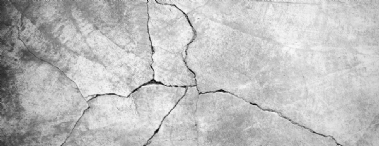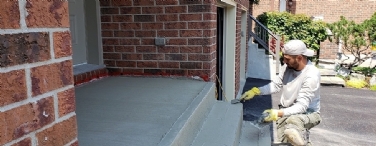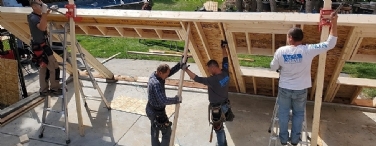
Do you have concrete floors in your home? If so, there's an option for covering the ugly, gray slab without using a rug or completely starting from scratch. You can use a concrete floor overlay to permanently cover up the concrete with a decorative finish, and this system costs much less money than ripping up the floor and starting from scratch. Resurfacing a concrete floor with an overlay gives the surface a beautiful, decorative finish that your guests will never believe is concrete!
What are Concrete Floor Overlays? At one time, concrete floors couldn't be effectively covered with anything permanent, but new technologies have made it possible to coat the existing concrete with an overlay. The old overlays would break down over time, but today's overlays mix polymer with cement to create a coating that adheres well to the surface of existing concrete. Depending on the polymer-cement overlay you choose, you can create a coating that is feather-thin or up to several inches thick. They also resist damage from water, chemicals, exposure to the weather, and abrasion due to high traffic, so they protect the floor as well. Most people, however, choose overlays for the bold, decorative choices available to transform the floor.
Types of Overlays
There are a few different types of overlays you can consider, depending on your ultimate goal of the project. For each, however, you have to start with structurally sound concrete flooring. These overlays make your concrete look nice, but they can't repair structural damage. Here are the different overlay systems you should consider:
- If your concrete is uneven, work, or otherwise damaged, yet structurally sound, you should consider underlayments or self-leveling overlays. These types of overlays are the thickest and can provide you with a smooth, level surface.
- On the other end of the spectrum, skim coats (also called microtoppings) are very thin and can actually be used on vertical surfaces as well. You trowel this kind of overlay onto your floor, so you can make the surface smooth or textured.
- Spray-down overlays give you a textured finish, but are extremely durable. As an added bonus, the sprayed texture makes the surface slip-resistant, so it is great for exterior spaces. Spray-down overlays are also the easiest to use with stencils.
- If you want to add a stamped texture, look for a stampable overlay system. These layers are thick enough to cover any texture of the current concrete, and can even hide minor imperfections. They're also thick enough to be stamped like traditional stamped concrete.
Cost of Overlay Systems
When choosing a contractor and a type of overlay, cost will probably be a factor. You can expect to spend as much money on an overlay system as you would on new tile for the same floor. Like with tile, the price ranges. You'll also pay more if you want multiple colours, intricate designs, or stamped patterns or texture treatments. Surfaces that are hard to cover, like tight spaces, may also mean that you'll pay more for the overlay.
Prepping you Concrete Surface for an Overlay
Some of the expense and time you put into an overlay project will come from preparation work you need to do on the current concrete surface so that the overlay sticks. If you don't do this prep work, the overlay will just crack and chip away. Preparation includes the following:
- The concrete surface needs to be totally clean, with all sealers, paint, and other coatings stripped away to reveal the raw concrete.
- Any cracks wider than a credit card should be repaired, or they'll show in the overlay. As you're repairing cracks, you should also remove any unsound concrete so that the overlay is going on a structurally sound surface.
- Lastly, you need to do a process known as profiling, which means that you make the surface of the concrete rough. That way, the overlay can grab the surface, sticking better. You can use a grinder or a sandblaster to do the profiling.
Doing the prep work yourself can help you save money on the overall project, so if there aren't many repairs to be made, you may want to clean and profile yourself rather than asking a contractor to do that part of the job.
Maintaining Overlays
Concrete overlays are extremely easy to maintain, as long as you choose the right sealer for the project. You need to reseal the surfaces occasionally, especially in high traffic areas or exterior surfaces that are exposed to harsh weather. As long as you keep the surface clean, however, your overlay should last a lifetime - simply use a cleaner made for concrete to remove dirt, grease, and other residue once every week or two. Your contractor can talk to you more about maintenance tips and the best sealer to use when the specific overlay you want is installed.
Posted by: TrustedPros





